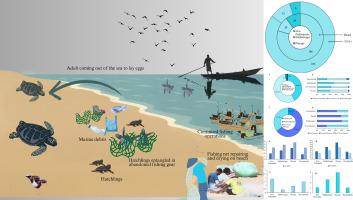评估海洋垃圾和废弃渔网对Olive Ridley幼崽的生态风险:来自印度东海岸全球知名的栖息地的见解。
IF 4.9
3区 环境科学与生态学
Q1 ENVIRONMENTAL SCIENCES
引用次数: 0
摘要
人为海洋垃圾已成为一个紧迫的环境挑战,对海洋生物和生态系统构成严重威胁。本研究评估了印度奥里萨邦Rushikulya繁殖地附近的四个主要Olive Ridley (Lepidochelys olivacea)筑巢海滩的凋落物组成、密度和生态影响,这是一个国际公认的大规模筑巢事件(称为arribadas)的地点。我们记录了1103件垃圾,其中塑料占85%以上。根据凋落物的物质组成、来源和浮力特性对凋落物进行了系统分类。计算的海滩质量指数显示,所有站点的环境质量都较差,其中清洁海岸指数(25.73 ~ 54.67)、塑料堆积指数(8.11 ~ 18.63)和污染负荷指数(18.96 ~ 27.63)表明污染严重。清洁环境指数(35.00-79.27)将所有海滩划分为“脏”到“极脏”,而危险物品指数(0.38-1.86)突出了危险垃圾的存在。总体而言,筑巢海滩的垃圾密度较高,包括跨界塑料垃圾。令人震惊的是,237只死亡和121只被缠住的幼崽被发现,主要被困在废弃的渔网和合成绳索中。我们的研究结果强调,迫切需要采取有针对性的保护措施,更严格地执行季节性捕捞禁令,并协调区域行动,以解决影响全球重要海龟筑巢栖息地之一的本地和跨境海洋垃圾问题。本文章由计算机程序翻译,如有差异,请以英文原文为准。

Evaluating the ecological risks of marine litter and derelict fishing nets on Olive Ridley hatchlings: Insights from a globally renowned rookery along the east coast of India
Anthropogenic marine litter have become a pressing environmental challenge, posing serious risks to marine organisms and the ecosystem. This study assessed litter composition, density, and ecological impact across four key Olive Ridley (Lepidochelys olivacea) nesting beaches near the Rushikulya rookery, Odisha, India, an internationally recognized site for mass nesting events known as arribadas. We recorded 1103 litter items, with plastics comprising over 85 % of the litter. Litter was systematically classified by its material composition, origin, and buoyant properties. The calculated beach quality indices revealed poor environmental quality across all sites, with clean coast index (25.73–54.67), plastic accumulation index (8.11–18.63), and pollution load index (18.96–27.63) indicating significant pollution. The clean environment index (35.00–79.27) classified all beaches as “dirty” to “extremely dirty,” while the hazardous items index (0.38–1.86) highlighted notable hazardous litter presence. Overall, the nesting beaches exhibited high litter density, including transboundary plastic litter. Alarmingly, 237 dead and 121 entangled hatchlings were found, primarily trapped in derelict fishing nets and synthetic ropes. Our findings highlight an urgent need for targeted conservation measures, stricter enforcement of seasonal fishing bans, and coordinated regional action to address local and transboundary marine litter impacting one of the globally important sea turtle nesting habitats.
求助全文
通过发布文献求助,成功后即可免费获取论文全文。
去求助
来源期刊

Marine pollution bulletin
环境科学-海洋与淡水生物学
CiteScore
10.20
自引率
15.50%
发文量
1077
审稿时长
68 days
期刊介绍:
Marine Pollution Bulletin is concerned with the rational use of maritime and marine resources in estuaries, the seas and oceans, as well as with documenting marine pollution and introducing new forms of measurement and analysis. A wide range of topics are discussed as news, comment, reviews and research reports, not only on effluent disposal and pollution control, but also on the management, economic aspects and protection of the marine environment in general.
 求助内容:
求助内容: 应助结果提醒方式:
应助结果提醒方式:


